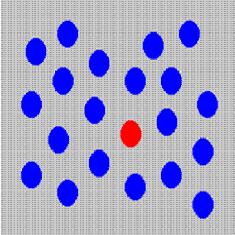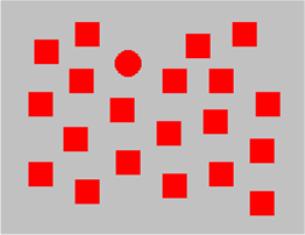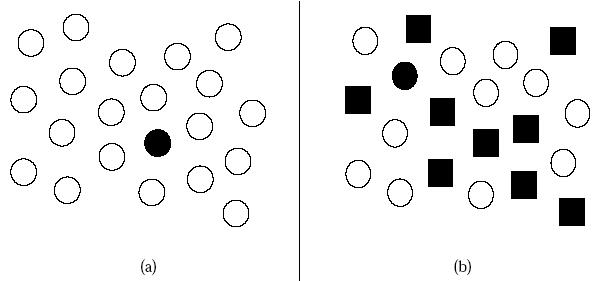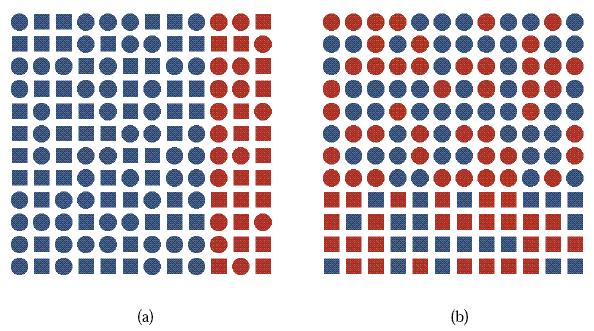Teaching:TUW - UE InfoVis WS 2005/06 - Gruppe G3 - Aufgabe 1 - Preattentive Processing: Difference between revisions
David.leeb (talk | contribs) No edit summary |
No edit summary |
||
| Line 2: | Line 2: | ||
{{Quotation|Visualization is so effective and useful because it utilizes one of the channels to our brain that have the highest bandwidths: our eyes. But even this channel can be used more or less efficiently. One special property of our visual system is preattentive processing. |[Ware, 2000; Treisman, 1985]}} | {{Quotation|Visualization is so effective and useful because it utilizes one of the channels to our brain that have the highest bandwidths: our eyes. But even this channel can be used more or less efficiently. One special property of our visual system is preattentive processing. |[Ware, 2000; Treisman, 1985]}} | ||
[Healey et al., 1996] shows that a discovery of the past 20 years was that there is a limited set of visual properties. Tasks, which can be accomplished within 200 milliseconds, are considered preattentive because eye movements need this time to initiate. Everything which can be perceived in this short time includes only absconding information. Attention can not be prefocused on a particular position if elements are set random. | |||
== Preattentive Features == | == Preattentive Features == | ||
Revision as of 13:23, 23 November 2009
Preattentive Processing
[Healey et al., 1996] shows that a discovery of the past 20 years was that there is a limited set of visual properties. Tasks, which can be accomplished within 200 milliseconds, are considered preattentive because eye movements need this time to initiate. Everything which can be perceived in this short time includes only absconding information. Attention can not be prefocused on a particular position if elements are set random.
Preattentive Features

Examples
Conclusion
Any visual processing of that item prior to the act of selection can be called “preattentive”.[Wolfe, Treisma, 2003]
Preattentive processing can help to rapidly draw the focus of attention to a target with a unique visual feature (i.e., little or no searching is required in the preattentive case). [Healey, 2005]
Ressources
- [Healey et al., 1996] Healey, C. G., Booth, K. S., and Enns, J. T.. High-Speed Visual Estimation Using Preattentive Processing. ACM Transactions on Human Computer Interaction 3(2), pages 107-135, Created at: 1996. http://www.csc.ncsu.edu/faculty/healey/download/tochi.96.pdf .
- [Wolfe, Treisma, 2003] Jeremy M Wolfe, Anne Treisma. What shall we do with the preattentive processing stage: Use it or lose it?, Todd S Horowitz poster presented at the Third Annual Meeting of the Vision Sciences Society. Sarasota. Created at: May, 2003. http://search.bwh.harvard.edu/links/talks/VSS03-JMW.pdf .
- [Healey, 2005] Christopher G. Healey. Perception in Visualization. Department of Computer Science, North Carolina State University. Created at: May, 2005. http://www.csc.ncsu.edu/faculty/healey/PP/index.html#Tri_Cog_Psych:80 .
- [Chipman, 1996] Gene Chipman. Review of High Speed Visual Estimation Using Preattantive Processing (Healy, Booth and Enns). Created at: 1996, Accessed at: November 05, 2009. http://www.cs.umd.edu/class/spring2002/cmsc838f/preattentive.ppt#267 .
- [Treisman, 1985] A. Treisman. Preattentive processing in vision. Computer Vision, Graphics, and Image Processing, 31:156–177, 1985.
- [Ware, 2000] C. Ware. Information Visualization: Perception for Design. Morgan Kaufmann Publishers, 2000.



